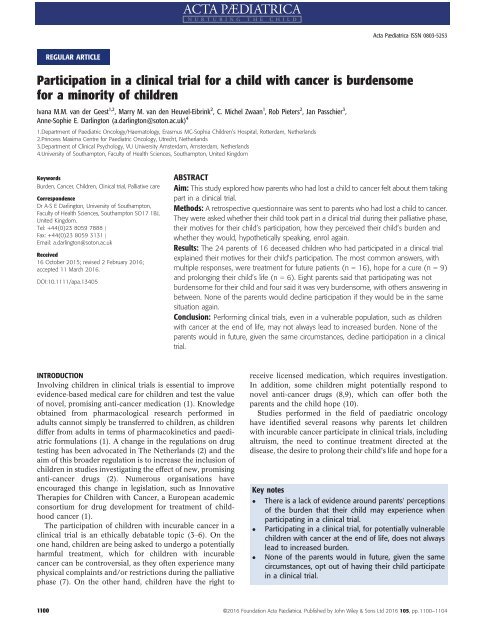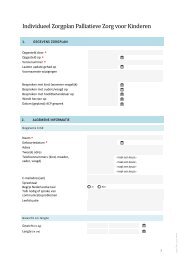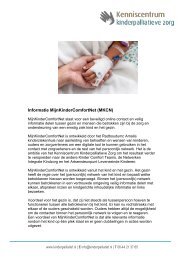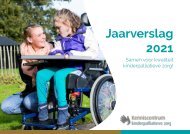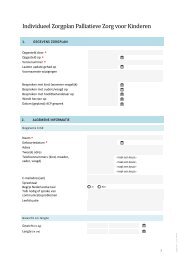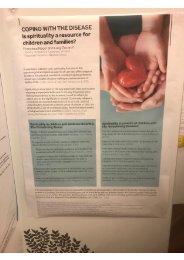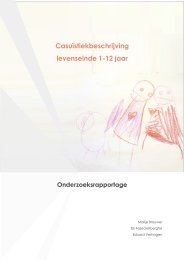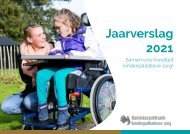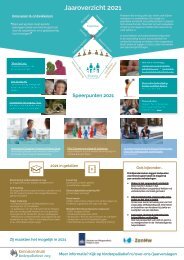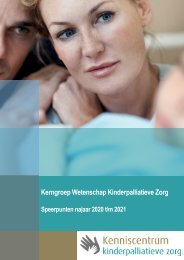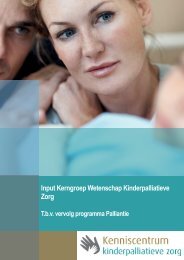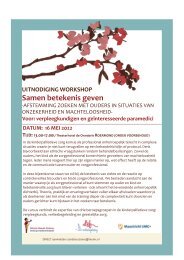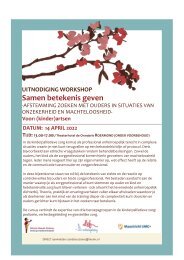Participation in a clinical trial for a child with cancer is burdensome for a minority of children
You also want an ePaper? Increase the reach of your titles
YUMPU automatically turns print PDFs into web optimized ePapers that Google loves.
Acta Pædiatrica ISSN 0803-5253<br />
REGULAR ARTICLE<br />
<strong>Participation</strong> <strong>in</strong> a cl<strong>in</strong>ical <strong>trial</strong> <strong>for</strong> a <strong>child</strong> <strong>with</strong> <strong>cancer</strong> <strong>is</strong> <strong>burdensome</strong><br />
<strong>for</strong> a m<strong>in</strong>ority <strong>of</strong> <strong>child</strong>ren<br />
Ivana M.M. van der Geest 1,2 , Marry M. van den Heuvel-Eibr<strong>in</strong>k 2 , C. Michel Zwaan 1 , Rob Pieters 2 , Jan Passchier 3 ,<br />
Anne-Sophie E. Darl<strong>in</strong>gton (a.darl<strong>in</strong>gton@soton.ac.uk) 4<br />
1.Department <strong>of</strong> Paediatric Oncology/Haematology, Erasmus MC-Sophia Children’s Hospital, Rotterdam, Netherlands<br />
2.Pr<strong>in</strong>cess Maxima Centre <strong>for</strong> Paediatric Oncology, Utrecht, Netherlands<br />
3.Department <strong>of</strong> Cl<strong>in</strong>ical Psychology, VU University Amsterdam, Amsterdam, Netherlands<br />
4.University <strong>of</strong> Southampton, Faculty <strong>of</strong> Health Sciences, Southampton, United K<strong>in</strong>gdom<br />
Keywords<br />
Burden, Cancer, Children, Cl<strong>in</strong>ical <strong>trial</strong>, Palliative care<br />
Correspondence<br />
Dr A-S E Darl<strong>in</strong>gton, University <strong>of</strong> Southampton,<br />
Faculty <strong>of</strong> Health Sciences, Southampton SO17 1BJ,<br />
United K<strong>in</strong>gdom.<br />
Tel: +44(0)23 8059 7888 |<br />
Fax: +44(0)23 8059 3131 |<br />
Email: a.darl<strong>in</strong>gton@soton.ac.uk<br />
Received<br />
16 October 2015; rev<strong>is</strong>ed 2 February 2016;<br />
accepted 11 March 2016.<br />
DOI:10.1111/apa.13405<br />
ABSTRACT<br />
Aim: Th<strong>is</strong> study explored how parents who had lost a <strong>child</strong> to <strong>cancer</strong> felt about them tak<strong>in</strong>g<br />
part <strong>in</strong> a cl<strong>in</strong>ical <strong>trial</strong>.<br />
Methods: A retrospective questionnaire was sent to parents who had lost a <strong>child</strong> to <strong>cancer</strong>.<br />
They were asked whether their <strong>child</strong> took part <strong>in</strong> a cl<strong>in</strong>ical <strong>trial</strong> dur<strong>in</strong>g their palliative phase,<br />
their motives <strong>for</strong> their <strong>child</strong>’s participation, how they perceived their <strong>child</strong>’s burden and<br />
whether they would, hypothetically speak<strong>in</strong>g, enrol aga<strong>in</strong>.<br />
Results: The 24 parents <strong>of</strong> 16 deceased <strong>child</strong>ren who had participated <strong>in</strong> a cl<strong>in</strong>ical <strong>trial</strong><br />
expla<strong>in</strong>ed their motives <strong>for</strong> their <strong>child</strong>’s participation. The most common answers, <strong>with</strong><br />
multiple responses, were treatment <strong>for</strong> future patients (n = 16), hope <strong>for</strong> a cure (n = 9)<br />
and prolong<strong>in</strong>g their <strong>child</strong>’s life (n = 6). Eight parents said that participat<strong>in</strong>g was not<br />
<strong>burdensome</strong> <strong>for</strong> their <strong>child</strong> and four said it was very <strong>burdensome</strong>, <strong>with</strong> others answer<strong>in</strong>g <strong>in</strong><br />
between. None <strong>of</strong> the parents would decl<strong>in</strong>e participation if they would be <strong>in</strong> the same<br />
situation aga<strong>in</strong>.<br />
Conclusion: Per<strong>for</strong>m<strong>in</strong>g cl<strong>in</strong>ical <strong>trial</strong>s, even <strong>in</strong> a vulnerable population, such as <strong>child</strong>ren<br />
<strong>with</strong> <strong>cancer</strong> at the end <strong>of</strong> life, may not always lead to <strong>in</strong>creased burden. None <strong>of</strong> the<br />
parents would <strong>in</strong> future, given the same circumstances, decl<strong>in</strong>e participation <strong>in</strong> a cl<strong>in</strong>ical<br />
<strong>trial</strong>.<br />
INTRODUCTION<br />
Involv<strong>in</strong>g <strong>child</strong>ren <strong>in</strong> cl<strong>in</strong>ical <strong>trial</strong>s <strong>is</strong> essential to improve<br />
evidence-based medical care <strong>for</strong> <strong>child</strong>ren and test the value<br />
<strong>of</strong> novel, prom<strong>is</strong><strong>in</strong>g anti-<strong>cancer</strong> medication (1). Knowledge<br />
obta<strong>in</strong>ed from pharmacological research per<strong>for</strong>med <strong>in</strong><br />
adults cannot simply be transferred to <strong>child</strong>ren, as <strong>child</strong>ren<br />
differ from adults <strong>in</strong> terms <strong>of</strong> pharmacok<strong>in</strong>etics and paediatric<br />
<strong>for</strong>mulations (1). A change <strong>in</strong> the regulations on drug<br />
test<strong>in</strong>g has been advocated <strong>in</strong> The Netherlands (2) and the<br />
aim <strong>of</strong> th<strong>is</strong> broader regulation <strong>is</strong> to <strong>in</strong>crease the <strong>in</strong>clusion <strong>of</strong><br />
<strong>child</strong>ren <strong>in</strong> studies <strong>in</strong>vestigat<strong>in</strong>g the effect <strong>of</strong> new, prom<strong>is</strong><strong>in</strong>g<br />
anti-<strong>cancer</strong> drugs (2). Numerous organ<strong>is</strong>ations have<br />
encouraged th<strong>is</strong> change <strong>in</strong> leg<strong>is</strong>lation, such as Innovative<br />
Therapies <strong>for</strong> Children <strong>with</strong> Cancer, a European academic<br />
consortium <strong>for</strong> drug development <strong>for</strong> treatment <strong>of</strong> <strong>child</strong>hood<br />
<strong>cancer</strong> (1).<br />
The participation <strong>of</strong> <strong>child</strong>ren <strong>with</strong> <strong>in</strong>curable <strong>cancer</strong> <strong>in</strong> a<br />
cl<strong>in</strong>ical <strong>trial</strong> <strong>is</strong> an ethically debatable topic (3–6). On the<br />
one hand, <strong>child</strong>ren are be<strong>in</strong>g asked to undergo a potentially<br />
harmful treatment, which <strong>for</strong> <strong>child</strong>ren <strong>with</strong> <strong>in</strong>curable<br />
<strong>cancer</strong> can be controversial, as they <strong>of</strong>ten experience many<br />
physical compla<strong>in</strong>ts and/or restrictions dur<strong>in</strong>g the palliative<br />
phase (7). On the other hand, <strong>child</strong>ren have the right to<br />
receive licensed medication, which requires <strong>in</strong>vestigation.<br />
In addition, some <strong>child</strong>ren might potentially respond to<br />
novel anti-<strong>cancer</strong> drugs (8,9), which can <strong>of</strong>fer both the<br />
parents and the <strong>child</strong> hope (10).<br />
Studies per<strong>for</strong>med <strong>in</strong> the field <strong>of</strong> paediatric oncology<br />
have identified several reasons why parents let <strong>child</strong>ren<br />
<strong>with</strong> <strong>in</strong>curable <strong>cancer</strong> participate <strong>in</strong> cl<strong>in</strong>ical <strong>trial</strong>s, <strong>in</strong>clud<strong>in</strong>g<br />
altru<strong>is</strong>m, the need to cont<strong>in</strong>ue treatment directed at the<br />
d<strong>is</strong>ease, the desire to prolong their <strong>child</strong>’s life and hope <strong>for</strong> a<br />
Key notes<br />
There <strong>is</strong> a lack <strong>of</strong> evidence around parents 0 perceptions<br />
<strong>of</strong> the burden that their <strong>child</strong> may experience when<br />
participat<strong>in</strong>g <strong>in</strong> a cl<strong>in</strong>ical <strong>trial</strong>.<br />
Participat<strong>in</strong>g <strong>in</strong> a cl<strong>in</strong>ical <strong>trial</strong>, <strong>for</strong> potentially vulnerable<br />
<strong>child</strong>ren <strong>with</strong> <strong>cancer</strong> at the end <strong>of</strong> life, does not always<br />
lead to <strong>in</strong>creased burden.<br />
None <strong>of</strong> the parents would <strong>in</strong> future, given the same<br />
circumstances, opt out <strong>of</strong> hav<strong>in</strong>g their <strong>child</strong> participate<br />
<strong>in</strong> a cl<strong>in</strong>ical <strong>trial</strong>.<br />
1100 ©2016 Foundation Acta Pædiatrica. Publ<strong>is</strong>hed by John Wiley & Sons Ltd 2016 105, pp. 1100–1104
van der Geest et al.<br />
Parents experiences <strong>of</strong> <strong>cancer</strong> <strong>trial</strong>s<br />
cure or a miracle (11–18). A study that explored the<br />
perspectives <strong>of</strong> cl<strong>in</strong>ical <strong>trial</strong> participation from the po<strong>in</strong>t <strong>of</strong><br />
view <strong>of</strong> adolescents, reported that most <strong>of</strong> the adolescents<br />
hoped that participation would result <strong>in</strong> a direct benefit <strong>for</strong><br />
themselves (19). Ulrich et al. has stated that more understand<strong>in</strong>g<br />
<strong>of</strong> the parents’ rationale <strong>for</strong> participation <strong>in</strong><br />
cl<strong>in</strong>ical <strong>trial</strong>s was necessary (20).<br />
Scarce <strong>in</strong><strong>for</strong>mation <strong>is</strong> available about the <strong>child</strong>’s burden<br />
<strong>of</strong> participation <strong>in</strong> cl<strong>in</strong>ical <strong>trial</strong>s (21). A qualitative study<br />
<strong>with</strong> six parents <strong>of</strong> <strong>child</strong>ren undergo<strong>in</strong>g haematopoietic<br />
stem cell treatment showed that most parents were positive<br />
about tak<strong>in</strong>g part <strong>in</strong> cl<strong>in</strong>ical research (17). Research <strong>in</strong><br />
healthy <strong>child</strong>ren and <strong>child</strong>ren <strong>with</strong> a chronic d<strong>is</strong>ease<br />
reported no significant unpleasantness from participat<strong>in</strong>g<br />
<strong>in</strong> medical research (22). It <strong>is</strong> important to understand<br />
whether parents felt that participation was <strong>burdensome</strong> <strong>for</strong><br />
their <strong>child</strong>, based on systematically collected <strong>in</strong><strong>for</strong>mation,<br />
which may improve further care.<br />
There<strong>for</strong>e, the aims <strong>of</strong> the present study were to exam<strong>in</strong>e:<br />
whether the <strong>child</strong> <strong>with</strong> <strong>in</strong>curable <strong>cancer</strong> participated <strong>in</strong> a<br />
research study <strong>for</strong> a new treatment (cl<strong>in</strong>ical <strong>trial</strong>), why the<br />
parents participated, the <strong>child</strong>’s perceived burden and<br />
whether parents would, given the same circumstances,<br />
participate <strong>in</strong> a research study <strong>for</strong> a new treatment.<br />
PATIENTS AND METHODS<br />
Participants<br />
The participants <strong>in</strong> th<strong>is</strong> study were parents who lost a <strong>child</strong><br />
to <strong>cancer</strong> between 2000 and 2004, dur<strong>in</strong>g or after treatment<br />
at the Department <strong>of</strong> Paediatric Oncology/Haematology,<br />
Erasmus Medical Centre, Sophia Children’s Hospital, The<br />
Netherlands. In total, the parents <strong>of</strong> 123/135 <strong>child</strong>ren were<br />
eligible <strong>for</strong> th<strong>is</strong> study. The parents <strong>of</strong> 12 <strong>child</strong>ren were not<br />
approached to participate <strong>in</strong> th<strong>is</strong> study as it was thought too<br />
<strong>burdensome</strong> (n = 5), because their <strong>child</strong> died <strong>in</strong> the diagnostic<br />
phase <strong>of</strong> <strong>child</strong>hood <strong>cancer</strong> (n = 2) or their <strong>child</strong> died<br />
because <strong>of</strong> a sudden toxic death dur<strong>in</strong>g treatment (n =2). In<br />
addition, the parents <strong>of</strong> two prematurely born <strong>in</strong>fants were<br />
not approached, as both <strong>in</strong>fants had multiple organ problems,<br />
and died very shortly after birth and one family was<br />
seek<strong>in</strong>g asylum at the time <strong>of</strong> their <strong>child</strong>’s death (23,24). A<br />
questionnaire was sent to all 246 parents, as part <strong>of</strong> a larger<br />
study <strong>in</strong> which we explored parents’ perspectives <strong>of</strong> paediatric<br />
palliative care (23,24). The median follow-up time<br />
between the <strong>child</strong> 0 s death and completion <strong>of</strong> the questionnaire<br />
was five years, <strong>with</strong> a range from three to eight years.<br />
Th<strong>is</strong> study was approved by the Medical Ethics Committee<br />
<strong>of</strong> the Erasmus Medical Centre, Rotterdam, The Netherlands<br />
(MEC number 2007–362).<br />
Measurement <strong>in</strong>strument<br />
The questionnaire was developed based on an extensive<br />
study <strong>of</strong> the literature, cl<strong>in</strong>ical experience and a pilot study<br />
that <strong>in</strong>cluded <strong>in</strong>terviews <strong>with</strong> three bereaved mothers from<br />
the Dutch Childhood Cancer Parent Organ<strong>is</strong>ation. The<br />
current study focused on the subset <strong>of</strong> questions <strong>in</strong> Table 1.<br />
The demographic character<strong>is</strong>tics <strong>of</strong> the <strong>child</strong> were collected,<br />
Table 1 Questions explor<strong>in</strong>g parents’ experiences <strong>of</strong> participation <strong>of</strong> their <strong>child</strong> <strong>with</strong><br />
<strong>in</strong>curable <strong>cancer</strong> <strong>in</strong> a cl<strong>in</strong>ical <strong>trial</strong><br />
Did your <strong>child</strong> participate <strong>in</strong> a research study <strong>for</strong> a new treatment?<br />
Yes<br />
No<br />
Don’t know<br />
If your <strong>child</strong> did, can you <strong>in</strong>dicate why? (more than one answer possible)<br />
Prolong<strong>in</strong>g my <strong>child</strong>’s life<br />
It gave us hope <strong>for</strong> a cure<br />
Treatment <strong>for</strong> future patients<br />
Other<br />
To what extent did you feel th<strong>is</strong> was <strong>burdensome</strong> <strong>for</strong> your <strong>child</strong>?<br />
1–2–3–4–5 (1= not <strong>burdensome</strong>; 5 = very <strong>burdensome</strong>)<br />
Would you, given the same circumstances, participate (aga<strong>in</strong>) <strong>in</strong> a research<br />
study <strong>for</strong> a new treatment?<br />
Yes, because<br />
No, because<br />
Don’t know, because<br />
<strong>in</strong>clud<strong>in</strong>g gender, age at death and diagnos<strong>is</strong>, categor<strong>is</strong>ed as<br />
haematological malignancy, solid tumour or bra<strong>in</strong> tumour.<br />
We also documented the parents’ gender and age.<br />
Data analys<strong>is</strong><br />
The data were analysed us<strong>in</strong>g Stat<strong>is</strong>tical Package <strong>for</strong> Social<br />
Science version 21.0 (SPSS Inc, Ill<strong>in</strong>o<strong>is</strong>, USA). Descriptive<br />
analyses were generated <strong>for</strong> all variables. Cont<strong>in</strong>uous data<br />
are presented as medians and ranges and categorical data<br />
are presented as numbers and percentages. Qualitative<br />
analyses us<strong>in</strong>g a framework approach were used to analyse<br />
the f<strong>in</strong>d<strong>in</strong>gs <strong>of</strong> the open-ended question, <strong>in</strong> which parents<br />
were asked why they would or would not participate aga<strong>in</strong><br />
<strong>in</strong> a cl<strong>in</strong>ical <strong>trial</strong> <strong>in</strong> future (25). Both parents were asked to<br />
complete the questionnaire. The data on one <strong>child</strong> was<br />
excluded, as the parents had not given a cons<strong>is</strong>tent answer<br />
to the question about participation. When one <strong>of</strong> the<br />
parents did not know whether the <strong>child</strong> had participated <strong>in</strong><br />
a cl<strong>in</strong>ical <strong>trial</strong>, documentation <strong>of</strong> the <strong>child</strong>’s participation<br />
was based on the other parents’ answer to th<strong>is</strong> question.<br />
RESULTS<br />
The questionnaire was completed by 89 parents <strong>of</strong> 57<br />
deceased <strong>child</strong>ren, a response rate was approximately 35%<br />
(23), and <strong>of</strong> these, 74 parents <strong>of</strong> 49 <strong>child</strong>ren completed the<br />
question about participation <strong>in</strong> a cl<strong>in</strong>ical <strong>trial</strong>. In total, 24<br />
parents <strong>of</strong> 16 <strong>child</strong>ren (33%) opted to have their <strong>child</strong><br />
participate <strong>in</strong> a cl<strong>in</strong>ical <strong>trial</strong> to test new medication, 45<br />
parents <strong>of</strong> 31 <strong>child</strong>ren (63%) chose not to and five parents<br />
said that they did not know. The parent and <strong>child</strong> character<strong>is</strong>tics<br />
<strong>of</strong> those who did and did not participate <strong>in</strong> a<br />
cl<strong>in</strong>ical <strong>trial</strong> are depicted <strong>in</strong> Table 2.<br />
Parents were allowed to give multiple reasons <strong>for</strong> participation<br />
and these were: treatment <strong>for</strong> future patients<br />
(n = 16); hope <strong>for</strong> a cure (n = 9); prolong<strong>in</strong>g their <strong>child</strong>’s<br />
life (n = 6) and various other reasons (n = 5). Two other<br />
©2016 Foundation Acta Pædiatrica. Publ<strong>is</strong>hed by John Wiley & Sons Ltd 2016 105, pp. 1100–1104 1101
Parents experiences <strong>of</strong> <strong>cancer</strong> <strong>trial</strong>s<br />
van der Geest et al.<br />
Table 2 Parent and <strong>child</strong> character<strong>is</strong>tics<br />
Cl<strong>in</strong>ical <strong>trial</strong> participants<br />
Non-cl<strong>in</strong>ical <strong>trial</strong> participants<br />
Parents 24 45<br />
Gender<br />
Male 10 (42%) 17 (38%)<br />
Female 14 (58%) 28 (62%)<br />
Age at time <strong>of</strong> 46 years [25–53 years] 43 years [31–59 years]<br />
questionnaire<br />
Child 16 31<br />
Gender<br />
Male 13 (81%) 22 (71%)<br />
Female 3 (19%) 9 (29%)<br />
Age at death 8 years [3–15 years] 8 years [1–17 years]<br />
Diagnos<strong>is</strong><br />
Haematological 9 (56%) 9 (29%)<br />
malignancy<br />
Solid tumour 5 (31%) 8 (26%)<br />
Bra<strong>in</strong> tumour 2 (13%) 14 (45%)<br />
Parent and <strong>child</strong> character<strong>is</strong>tics presented <strong>for</strong> participants and nonparticipants<br />
(n = 69 parents; n = 47 <strong>child</strong>ren). Cont<strong>in</strong>uous data are<br />
presented as median and range; categorical data are presented as numbers<br />
and percentages.<br />
considerations <strong>in</strong>cluded: the <strong>child</strong> wanted to participate<br />
and another <strong>child</strong> was cured <strong>with</strong> th<strong>is</strong> medication. The<br />
rema<strong>in</strong><strong>in</strong>g parents who replied other did not specify their<br />
reasons clearly.<br />
The parents were asked “to what extent did you feel th<strong>is</strong><br />
was <strong>burdensome</strong> <strong>for</strong> your <strong>child</strong>” on a scale <strong>of</strong> one to five,<br />
eight parents scored th<strong>is</strong> a one (not <strong>burdensome</strong>), and four<br />
parents scored it a five (very <strong>burdensome</strong>). The rema<strong>in</strong><strong>in</strong>g<br />
parents responded <strong>with</strong> scores between two and four<br />
(Fig. 1). We also asked the parents “would you, given the<br />
same circumstances, participate (aga<strong>in</strong>) <strong>in</strong> a research study<br />
<strong>for</strong> a new treatment?”: 17/24 parents (71%) responded yes,<br />
six parents did not know, none <strong>of</strong> the parents said no and<br />
one response was m<strong>is</strong>s<strong>in</strong>g. Of the 17 parents who would<br />
consent to their <strong>child</strong> participat<strong>in</strong>g aga<strong>in</strong> <strong>in</strong> a cl<strong>in</strong>ical <strong>trial</strong>,<br />
14 outl<strong>in</strong>ed their reason(s) <strong>in</strong> an open-ended question. Four<br />
themes were identified that expla<strong>in</strong>ed why they would<br />
participate aga<strong>in</strong> <strong>in</strong> a cl<strong>in</strong>ical <strong>trial</strong>: altru<strong>is</strong>m, the perceived<br />
benefits <strong>for</strong> the <strong>child</strong>, hav<strong>in</strong>g explored all possibilities and<br />
the <strong>child</strong>’s w<strong>is</strong>h to participate. Some parents underscored<br />
the importance <strong>of</strong> a limited burden <strong>of</strong> participation. The<br />
themes and correspond<strong>in</strong>g quotes are presented <strong>in</strong> Table 3.<br />
DISCUSSION<br />
Th<strong>is</strong> retrospective study explored parents’ views about their<br />
<strong>child</strong> <strong>with</strong> <strong>in</strong>curable <strong>cancer</strong>, participat<strong>in</strong>g <strong>in</strong> a cl<strong>in</strong>ical <strong>trial</strong><br />
dur<strong>in</strong>g the palliative phase. We focused on the perceived<br />
burden <strong>for</strong> the <strong>child</strong> dur<strong>in</strong>g the <strong>trial</strong> and how bereaved<br />
parents viewed their experiences <strong>of</strong> participation <strong>in</strong> retrospect,<br />
<strong>in</strong>clud<strong>in</strong>g whether they would participate <strong>in</strong> another<br />
cl<strong>in</strong>ical <strong>trial</strong> if the circumstances were to ar<strong>is</strong>e aga<strong>in</strong>.<br />
Approximately one-third <strong>of</strong> the <strong>child</strong>ren <strong>with</strong> <strong>in</strong>curable<br />
<strong>cancer</strong> <strong>in</strong> our sample participated <strong>in</strong> a cl<strong>in</strong>ical <strong>trial</strong> dur<strong>in</strong>g<br />
the palliative phase. Mak<strong>in</strong>g dec<strong>is</strong>ions about enroll<strong>in</strong>g <strong>in</strong><br />
cl<strong>in</strong>ical <strong>trial</strong>s, or lett<strong>in</strong>g their <strong>child</strong> receive supportive<br />
care, <strong>is</strong> one <strong>of</strong> the most difficult dec<strong>is</strong>ions parents can<br />
face as their <strong>child</strong> nears death (16,26). Some parents<br />
experience difficulties around the dec<strong>is</strong>ion to let their<br />
<strong>child</strong> participate, because they feel that there <strong>is</strong> no other<br />
option <strong>for</strong> their <strong>child</strong> besides participat<strong>in</strong>g <strong>in</strong> the cl<strong>in</strong>ical<br />
<strong>trial</strong> (13). In agreement <strong>with</strong> previous studies, our study<br />
<strong>in</strong>dicated that improv<strong>in</strong>g care <strong>for</strong> future patients was the<br />
ma<strong>in</strong> driver <strong>for</strong> cl<strong>in</strong>ical <strong>trial</strong> participation (12–18). Previous<br />
studies around participation <strong>of</strong> <strong>child</strong>ren and/or<br />
parents at the end <strong>of</strong> life <strong>in</strong> research other than cl<strong>in</strong>ical<br />
<strong>trial</strong>s reported similar motives (27,28). Parents may have<br />
redef<strong>in</strong>ed their goals and f<strong>in</strong>d com<strong>for</strong>t <strong>in</strong> giv<strong>in</strong>g mean<strong>in</strong>g<br />
to their <strong>child</strong>’s life (6, 27,29). Several parents <strong>in</strong> the<br />
current study participated <strong>in</strong> the <strong>trial</strong> because they hoped<br />
their <strong>child</strong> might be cured, although a cure was very<br />
unlikely <strong>in</strong> these <strong>child</strong>ren. Parents and <strong>child</strong>ren who<br />
consider participation should there<strong>for</strong>e be aware <strong>of</strong> the<br />
real<strong>is</strong>tic outcomes <strong>of</strong> a cl<strong>in</strong>ical <strong>trial</strong> (10,30). Other parents<br />
stressed <strong>of</strong> prolong<strong>in</strong>g their <strong>child</strong>’s life. Parents’ hope <strong>for</strong><br />
a cure and/or w<strong>is</strong>h to prolong their <strong>child</strong>’s life possibly<br />
reflect the v<strong>is</strong>ion <strong>of</strong> be<strong>in</strong>g a good parent <strong>in</strong> relation to<br />
mak<strong>in</strong>g dec<strong>is</strong>ions (31,32). Th<strong>is</strong> concept <strong>is</strong> def<strong>in</strong>ed as<br />
mak<strong>in</strong>g dec<strong>is</strong>ions <strong>in</strong> the <strong>child</strong>’s best <strong>in</strong>terest (16,32).<br />
Parents recogn<strong>is</strong>e their role <strong>in</strong> the <strong>in</strong>curable illness<br />
trajectory as seek<strong>in</strong>g further treatment options along <strong>with</strong><br />
symptom-directed and supportive therapy (31). S<strong>in</strong>ce we<br />
asked parents <strong>in</strong> retrospect <strong>for</strong> their reasons <strong>for</strong> participation<br />
<strong>in</strong> a cl<strong>in</strong>ical <strong>trial</strong>, th<strong>is</strong> could bias the actual number<br />
<strong>of</strong> parents <strong>for</strong> whom these reasons were <strong>of</strong> value. It <strong>is</strong><br />
possible that parents changed their motives over time,<br />
follow<strong>in</strong>g changes <strong>in</strong> their hopes and goals <strong>for</strong> care as<br />
their <strong>child</strong>’s physical condition changed (29,33).<br />
The current study was the first that showed that participation<br />
<strong>in</strong> a cl<strong>in</strong>ical <strong>trial</strong> was only perceived as very<br />
<strong>burdensome</strong> <strong>for</strong> a m<strong>in</strong>ority <strong>of</strong> <strong>child</strong>ren. Th<strong>is</strong> f<strong>in</strong>d<strong>in</strong>g <strong>is</strong> an<br />
important contribution to th<strong>is</strong> underdeveloped field <strong>in</strong><br />
paediatric palliative care. None <strong>of</strong> the parents would<br />
decl<strong>in</strong>e participation <strong>in</strong> a cl<strong>in</strong>ical <strong>trial</strong> if confronted <strong>with</strong> a<br />
similar dec<strong>is</strong>ion <strong>in</strong> future. Th<strong>is</strong> <strong>is</strong> congruent <strong>with</strong> a qualitative<br />
study per<strong>for</strong>med <strong>in</strong> <strong>child</strong>ren and parents <strong>of</strong> <strong>child</strong>ren<br />
undergo<strong>in</strong>g haematopoietic stem cell transplantation (17).<br />
Hence, per<strong>for</strong>m<strong>in</strong>g cl<strong>in</strong>ical <strong>trial</strong>s, even <strong>in</strong> a vulnerable<br />
population such as <strong>child</strong>ren <strong>with</strong> <strong>cancer</strong> at the end <strong>of</strong> life,<br />
seems important to parents and <strong>child</strong>ren.<br />
The question rema<strong>in</strong>s about what physicians can do to<br />
best support parents who are consider<strong>in</strong>g cl<strong>in</strong>ical <strong>trial</strong><br />
participation <strong>for</strong> their <strong>child</strong> <strong>with</strong> <strong>in</strong>curable <strong>cancer</strong>. Add<strong>in</strong>g<br />
to the current standards <strong>of</strong> provid<strong>in</strong>g <strong>in</strong><strong>for</strong>med consent <strong>for</strong><br />
paediatric cl<strong>in</strong>ical <strong>trial</strong>s, such as giv<strong>in</strong>g clear and detailed<br />
<strong>in</strong><strong>for</strong>mation about the cl<strong>in</strong>ical <strong>trial</strong> (10,34), it might be<br />
helpful to explore parents’ patterns <strong>of</strong> th<strong>in</strong>k<strong>in</strong>g, <strong>for</strong> <strong>in</strong>stance<br />
whether they are locked <strong>in</strong>to th<strong>in</strong>k<strong>in</strong>g that their <strong>child</strong> can<br />
be cured. Th<strong>is</strong> <strong>is</strong> valuable as parents <strong>with</strong> different<br />
perspectives might have different care goals as a result<br />
(11). For <strong>in</strong>stance, parents who choose supportive care<br />
alone dur<strong>in</strong>g the palliative phase focus more <strong>of</strong>ten on the<br />
1102 ©2016 Foundation Acta Pædiatrica. Publ<strong>is</strong>hed by John Wiley & Sons Ltd 2016 105, pp. 1100–1104
van der Geest et al.<br />
Parents experiences <strong>of</strong> <strong>cancer</strong> <strong>trial</strong>s<br />
1 (Not <strong>burdensome</strong>)<br />
2<br />
3<br />
4<br />
0 2 4 6 8 10<br />
Number <strong>of</strong> parents<br />
5 (Very <strong>burdensome</strong>)<br />
Figure 1 Child’s burden <strong>of</strong> participation accord<strong>in</strong>g to parents. Burden was scored on a five-po<strong>in</strong>t Likert scale, rang<strong>in</strong>g from one (not <strong>burdensome</strong>) to five (very<br />
<strong>burdensome</strong>).<br />
Table 3 Parents’ motives <strong>for</strong> participat<strong>in</strong>g (aga<strong>in</strong>) <strong>in</strong> a cl<strong>in</strong>ical <strong>trial</strong> (n = 14/17)<br />
Altru<strong>is</strong>m<br />
‘Otherw<strong>is</strong>e successful new treatments will never be d<strong>is</strong>covered’<br />
‘Research <strong>is</strong> very important’<br />
‘Hope <strong>for</strong> a better treatment’<br />
‘Maybe other <strong>child</strong>ren can now be cured’<br />
‘If others had not done the same <strong>in</strong> the past, they wouldn’t be able to<br />
cure as many <strong>child</strong>ren as they do now’<br />
‘[...] and you might be able to prevent others from experienc<strong>in</strong>g th<strong>is</strong><br />
sadness’<br />
‘The type <strong>of</strong> leukaemia was rare, and future patients could benefit from<br />
th<strong>is</strong> research’<br />
‘I still hope <strong>for</strong> cure <strong>for</strong> these <strong>child</strong>ren’<br />
‘As long as the <strong>child</strong> doesn’t suffer any negative consequences it will<br />
help others’<br />
Perceived benefits <strong>for</strong> the <strong>child</strong><br />
‘You want the best <strong>for</strong> your <strong>child</strong>’<br />
‘Prolonged <strong>child</strong>’s life [...].’<br />
Hav<strong>in</strong>g explored all possibilities<br />
‘To pull out all the stops’<br />
‘[...] gave us hope’<br />
‘You want to try everyth<strong>in</strong>g [...]’<br />
Child’s w<strong>is</strong>h to participate<br />
‘Our <strong>child</strong> really wanted th<strong>is</strong>’<br />
fact that the <strong>child</strong> will not survive and m<strong>in</strong>im<strong>is</strong><strong>in</strong>g the<br />
<strong>child</strong>’s suffer<strong>in</strong>g (11). Healthcare pr<strong>of</strong>essionals might help<br />
parents to strike a balance between the benefits <strong>of</strong><br />
participation <strong>in</strong> a cl<strong>in</strong>ical <strong>trial</strong>, but also preserv<strong>in</strong>g the<br />
<strong>child</strong>’s needs and protect<strong>in</strong>g them from severe suffer<strong>in</strong>g<br />
(11,17, 27).<br />
The strength <strong>of</strong> th<strong>is</strong> study <strong>is</strong> that we demonstrated some<br />
new and important contributions, particularly the burden <strong>of</strong><br />
participation and whether or not parents would enrol their<br />
<strong>child</strong> aga<strong>in</strong>, which positively add to the limited <strong>in</strong><strong>for</strong>mation<br />
<strong>in</strong> th<strong>is</strong> field. Th<strong>is</strong> study has several limitations. First, we did<br />
not have any additional <strong>in</strong><strong>for</strong>mation on why some parents<br />
perceived their <strong>child</strong>’s participation as <strong>burdensome</strong> and<br />
whether the burden was physical or psychological <strong>in</strong> nature.<br />
In addition, it <strong>is</strong> possible that <strong>child</strong>ren suffered dur<strong>in</strong>g the<br />
palliative phase, which committed parents to participation<br />
<strong>in</strong> the cl<strong>in</strong>ical <strong>trial</strong>. In addition, caution on the conclusions<br />
that can be drawn <strong>is</strong> important because <strong>of</strong> the limited<br />
sample size, recall bias and the retrospective design. Lastly,<br />
the use <strong>of</strong> a s<strong>in</strong>gle unvalidated Likert scale to measure<br />
parents’ perceived burden <strong>of</strong> cl<strong>in</strong>ical <strong>trial</strong> participation<br />
limits the present study.<br />
In future, there <strong>is</strong> a need to collect <strong>in</strong><strong>for</strong>mation prospectively<br />
be<strong>for</strong>e, dur<strong>in</strong>g and after a cl<strong>in</strong>ical <strong>trial</strong>, <strong>in</strong> order to<br />
support our f<strong>in</strong>d<strong>in</strong>gs, to have a better understand<strong>in</strong>g <strong>of</strong> the<br />
parents’ and <strong>child</strong>’s perspectives, and assure that parents<br />
have real<strong>is</strong>tic expectations <strong>of</strong> what the <strong>trial</strong> might be able to<br />
achieve <strong>for</strong> their <strong>child</strong>. Understand<strong>in</strong>g parents’ reasons <strong>for</strong><br />
not enroll<strong>in</strong>g <strong>in</strong> a cl<strong>in</strong>ical <strong>trial</strong>, and a more <strong>in</strong>-depth<br />
exploration <strong>of</strong> the nature <strong>of</strong> the <strong>child</strong>’s burden would<br />
provide valuable <strong>in</strong><strong>for</strong>mation.<br />
CONCLUSION<br />
The results <strong>of</strong> th<strong>is</strong> retrospective study showed that one-third<br />
<strong>of</strong> <strong>child</strong>ren <strong>with</strong> <strong>in</strong>curable <strong>cancer</strong> <strong>in</strong> our sample participated<br />
<strong>in</strong> a cl<strong>in</strong>ical <strong>trial</strong>. Treatment <strong>for</strong> future patients was the most<br />
frequent rationale reported by parents who decided to enter<br />
a cl<strong>in</strong>ical <strong>trial</strong>, followed by hope <strong>for</strong> a cure and prolongation<br />
<strong>of</strong> the <strong>child</strong>’s life. A m<strong>in</strong>ority <strong>of</strong> parents reported that<br />
participation placed a burden on the <strong>child</strong>. None <strong>of</strong> the<br />
parents would, given the same circumstances, decl<strong>in</strong>e<br />
participation <strong>in</strong> a cl<strong>in</strong>ical <strong>trial</strong>. Per<strong>for</strong>m<strong>in</strong>g cl<strong>in</strong>ical <strong>trial</strong>s,<br />
even <strong>in</strong> a vulnerable population such as <strong>child</strong>ren <strong>with</strong><br />
<strong>cancer</strong> at the end <strong>of</strong> life, may not always lead to <strong>in</strong>creased<br />
burden.<br />
ACKNOWLEDGEMENTS<br />
We would like to thank the mothers <strong>of</strong> the Dutch Childhood<br />
Cancer Parent Organ<strong>is</strong>ation who critically reviewed<br />
the questionnaire about parents’ experiences <strong>of</strong> care dur<strong>in</strong>g<br />
the paediatric palliative phase.<br />
AUTHOR DISCLOSURE STATEMENT<br />
No conflicts <strong>of</strong> <strong>in</strong>terest.<br />
FINANCIAL DISCLOSURE<br />
No specific fund<strong>in</strong>g.<br />
©2016 Foundation Acta Pædiatrica. Publ<strong>is</strong>hed by John Wiley & Sons Ltd 2016 105, pp. 1100–1104 1103
Parents experiences <strong>of</strong> <strong>cancer</strong> <strong>trial</strong>s<br />
van der Geest et al.<br />
References<br />
1. Zwaan CM, Kearns P, Caron H, Verschuur A, Riccardi R, Boos<br />
J, et al. The role <strong>of</strong> the ‘<strong>in</strong>novative therapies <strong>for</strong> <strong>child</strong>ren <strong>with</strong><br />
<strong>cancer</strong>’ (ITCC) European consortium. Cancer Treat Rev 2010;<br />
36: 328–34.<br />
2. Comm<strong>is</strong>sie Doek.Advies med<strong>is</strong>ch-wetenschappelijk onderzoek<br />
met k<strong>in</strong>deren. 2009. Available from URL http://<br />
www.rijksoverheid.nl/documenten-en-publicaties/<br />
kamerstukken/2009/11/26/advies-comm<strong>is</strong>sie-doek.html<br />
(accessed April 16, 2015).<br />
3. F<strong>in</strong>e PG. Maximiz<strong>in</strong>g benefits and m<strong>in</strong>imiz<strong>in</strong>g r<strong>is</strong>ks <strong>in</strong> palliative<br />
care research that <strong>in</strong>volves patients near the end <strong>of</strong> life. J Pa<strong>in</strong><br />
Symptom Manage 2003; 25: S53–62.<br />
4. Stevens T, Wilde D, Paz S, Ahmedzai SH, Rawson A, Wragg D.<br />
Palliative care research protocols: a special case <strong>for</strong> ethical<br />
review? Palliat Med 2003; 17: 482–90.<br />
5. Duke S, Bennett H. Review: a narrative review <strong>of</strong> the publ<strong>is</strong>hed<br />
ethical debates <strong>in</strong> palliative care research and an assessment <strong>of</strong><br />
their adequacy to <strong>in</strong><strong>for</strong>m research governance. Palliat Med<br />
2010; 24: 111–26.<br />
6. Rapoport A. Address<strong>in</strong>g ethical concerns regard<strong>in</strong>g pediatric<br />
palliative care research. Arch Pediatr Adolesc Med 2009; 163:<br />
688–91.<br />
7. Wolfe J, Grier HE, Klar N, Lev<strong>in</strong> SB, Ellenbogen JM,<br />
Salem-Schatz S, et al. Symptoms and suffer<strong>in</strong>g at the end <strong>of</strong><br />
life <strong>in</strong> <strong>child</strong>ren <strong>with</strong> <strong>cancer</strong>. N Engl J Med 2000; 342: 326–33.<br />
8. Lee DP, Skolnik JM, Adamson PC. Pediatric phase I <strong>trial</strong>s <strong>in</strong><br />
oncology: an analys<strong>is</strong> <strong>of</strong> study conduct efficiency. J Cl<strong>in</strong> Oncol<br />
2005; 23: 8431–41.<br />
9. Horstmann E, McCabe MS, Grochow L, Yamamoto S,<br />
Rub<strong>in</strong>ste<strong>in</strong> L, Budd T, et al. R<strong>is</strong>ks and benefits <strong>of</strong> phase 1<br />
oncology <strong>trial</strong>s, 1991 through 2002. N Engl J Med 2005; 352:<br />
895–904.<br />
10. Carter BS, Levetown M, Friebert SE. Palliative care <strong>for</strong> <strong>in</strong>fants,<br />
<strong>child</strong>ren, and adolescents: a practical handbook. Baltimore,<br />
MD: Johns Hopk<strong>in</strong>s University Press, 2011.<br />
11. Maurer SH, H<strong>in</strong>ds PS, Spunt SL, Furman WL, Kane JR, Baker<br />
JN. Dec<strong>is</strong>ion mak<strong>in</strong>g by parents <strong>of</strong> <strong>child</strong>ren <strong>with</strong> <strong>in</strong>curable<br />
<strong>cancer</strong> who opt <strong>for</strong> enrollment on a phase I <strong>trial</strong> compared <strong>with</strong><br />
choos<strong>in</strong>g a do not resuscitate/term<strong>in</strong>al care option. J Cl<strong>in</strong><br />
Oncol 2010; 28: 3292–8.<br />
12. Barrera M, D’Agost<strong>in</strong>o N, Gammon J, Spencer L, Baruchel S.<br />
Health-related quality <strong>of</strong> life and enrollment <strong>in</strong> phase 1 <strong>trial</strong>s <strong>in</strong><br />
<strong>child</strong>ren <strong>with</strong> <strong>in</strong>curable <strong>cancer</strong>. Palliat Support Care 2005; 3:<br />
191–6.<br />
13. Deatrick JA, Angst DB, Moore C. Parents’ views <strong>of</strong> their<br />
<strong>child</strong>ren’s participation <strong>in</strong> phase I oncology cl<strong>in</strong>ical <strong>trial</strong>s.<br />
J Pediatr Oncol Nurs 2002; 19: 114–21.<br />
14. Truong TH, Weeks JC, Cook EF, J<strong>of</strong>fe S. Outcomes <strong>of</strong> <strong>in</strong><strong>for</strong>med<br />
consent among parents <strong>of</strong> <strong>child</strong>ren <strong>in</strong> <strong>cancer</strong> cl<strong>in</strong>ical <strong>trial</strong>s.<br />
Pediatr Blood Cancer 2011; 57: 998–1004.<br />
15. Simon C, Eder M, Kod<strong>is</strong>h E, Sim<strong>in</strong><strong>of</strong>f L. Altru<strong>is</strong>tic d<strong>is</strong>course <strong>in</strong><br />
the <strong>in</strong><strong>for</strong>med consent process <strong>for</strong> <strong>child</strong>hood <strong>cancer</strong> cl<strong>in</strong>ical<br />
<strong>trial</strong>s. Am J Bioeth 2006; 6: 40–7.<br />
16. H<strong>in</strong>ds PS, Drew D, Oakes LL, Fouladi M, Spunt SL, Church C,<br />
et al. End-<strong>of</strong>-life care preferences <strong>of</strong> pediatric patients <strong>with</strong><br />
<strong>cancer</strong>. J Cl<strong>in</strong> Oncol 2005; 23: 9146–54.<br />
17. Keusch F, Rao R, Chang L, Lepkowski J, Reddy P, Choi SW.<br />
<strong>Participation</strong> <strong>in</strong> cl<strong>in</strong>ical research: perspectives <strong>of</strong> adult patients<br />
and parents <strong>of</strong> pediatric patients undergo<strong>in</strong>g hematopoietic<br />
stem cell transplantation. Biol Blood Marrow Transplant 2014;<br />
20: 1604–11.<br />
18. Berg SL, W<strong>in</strong>ick N, Ingle AM, Adamson PC, Blaney SM.<br />
Reasons <strong>for</strong> participation <strong>in</strong> optional pharmacok<strong>in</strong>etic studies<br />
<strong>in</strong> <strong>child</strong>ren <strong>with</strong> <strong>cancer</strong>: a <strong>child</strong>ren’s oncology group phase 1<br />
consortium study. Pediatr Blood Cancer 2010; 55: 119–22.<br />
19. Miller VA, Baker JN, Leek AC, Hizlan S, Rhe<strong>in</strong>gold SR,<br />
Yamokoski AD, et al. Adolescent perspectives on phase I<br />
<strong>cancer</strong> research. Pediatr Blood Cancer 2013; 60: 873–8.<br />
20. Ulrich CM, Grady C, Wendler D. Palliative care: a supportive<br />
adjunct to pediatric phase I cl<strong>in</strong>ical <strong>trial</strong>s <strong>for</strong> anti<strong>cancer</strong><br />
agents? Pediatrics 2004; 114: 852–5.<br />
21. Toml<strong>in</strong>son D, Bartels U, Hendershot E, Constant<strong>in</strong> J, Wrathall<br />
G, Sung L. Challenges to participation <strong>in</strong> paediatric palliative<br />
care research: a review <strong>of</strong> the literature. Palliat Med 2007; 21:<br />
435–40.<br />
22. Hunfeld JA, Passchier J. <strong>Participation</strong> <strong>in</strong> medical research; a<br />
systematic review <strong>of</strong> the understand<strong>in</strong>g and experience <strong>of</strong><br />
<strong>child</strong>ren and adolescents. Patient Educ Couns 2012; 87: 268–76.<br />
23. van der Geest IM, Darl<strong>in</strong>gton AS, Streng IC, Michiels EM,<br />
Pieters R, van den Heuvel-Eibr<strong>in</strong>k MM. Parents’ experiences <strong>of</strong><br />
pediatric palliative care and the impact on long-term parental<br />
grief. J Pa<strong>in</strong> Symptom Manage 2014; 47: 1043–53.<br />
24. van der Geest IM, van den Heuvel-Eibr<strong>in</strong>k MM, Falkenburg N,<br />
Michiels EM, van Vliet L, Pieters R, et al. Parents’ faith and<br />
hope dur<strong>in</strong>g the pediatric palliative phase and the association<br />
<strong>with</strong> long-term parental adjustment. J Palliat Med 2015; 18:<br />
402–7.<br />
25. Ritchie J, Lew<strong>is</strong> J. Qualitative research practice: a guide <strong>for</strong><br />
social science students and researchers. London: SAGE, 2003.<br />
26. H<strong>in</strong>ds PS, Oakes L, Furman W, Quargnenti A, Olson MS,<br />
Foppiano P, et al. End-<strong>of</strong>-life dec<strong>is</strong>ion mak<strong>in</strong>g by adolescents,<br />
parents, and healthcare providers <strong>in</strong> pediatric oncology:<br />
research to evidence-based practice guidel<strong>in</strong>es. Cancer Nurs<br />
2001; 24: 122–34. quiz 35-6.<br />
27. Steele R, Cadell S, Siden H, Andrews G, Smit Quosai T,<br />
Feicht<strong>in</strong>ger L. Impact <strong>of</strong> research participation on parents <strong>of</strong><br />
seriously ill <strong>child</strong>ren. J Palliat Med 2014; 17: 788–96.<br />
28. Dyregrov K. Bereaved parents’ experience <strong>of</strong> research<br />
participation. Soc Sci Med 2004; 58: 391–400.<br />
29. Hill DL, Miller V, Walter JK, Carroll KW, Morr<strong>is</strong>on WE,<br />
Munson DA, et al. Regoal<strong>in</strong>g: a conceptual model <strong>of</strong> how<br />
parents <strong>of</strong> <strong>child</strong>ren <strong>with</strong> serious illness change medical care<br />
goals. BMC Palliat Care 2014; 13: 9.<br />
30. American Academy <strong>of</strong> Pediatrics. Committee on bioethics and<br />
committee on hospital care palliative care <strong>for</strong> <strong>child</strong>ren.<br />
Pediatrics 2000; 106: 351–7.<br />
31. Bluebond-Langner M, Belasco JB, Goldman A, Belasco C.<br />
Understand<strong>in</strong>g parents’ approaches to care and treatment <strong>of</strong><br />
<strong>child</strong>ren <strong>with</strong> <strong>cancer</strong> when standard therapy has failed. J Cl<strong>in</strong><br />
Oncol 2007; 25: 2414–9.<br />
32. H<strong>in</strong>ds PS, Oakes LL, Hicks J, Powell B, Srivastava DK, Spunt<br />
SL, et al. “Try<strong>in</strong>g to be a good parent” as def<strong>in</strong>ed by <strong>in</strong>terviews<br />
<strong>with</strong> parents who made phase I, term<strong>in</strong>al care, and<br />
resuscitation dec<strong>is</strong>ions <strong>for</strong> their <strong>child</strong>ren. J Cl<strong>in</strong> Oncol 2009;<br />
27: 5979–85.<br />
33. Granek L, Barrera M, Shaheed J, Nicholas D, Beaune L,<br />
D’Agost<strong>in</strong>o N, et al. Trajectory <strong>of</strong> parental hope when a <strong>child</strong><br />
has difficult-to-treat <strong>cancer</strong>: a prospective qualitative study.<br />
Psychooncology 2013; 22: 2436–44.<br />
34. Baker JN, Leek AC, Salas HS, Drotar D, Noll R, Rhe<strong>in</strong>gold SR,<br />
et al. Suggestions from adolescents, young adults, and parents<br />
<strong>for</strong> improv<strong>in</strong>g <strong>in</strong><strong>for</strong>med consent <strong>in</strong> phase 1 pediatric oncology<br />
<strong>trial</strong>s. Cancer 2013; 119: 4154–61.<br />
1104 ©2016 Foundation Acta Pædiatrica. Publ<strong>is</strong>hed by John Wiley & Sons Ltd 2016 105, pp. 1100–1104


